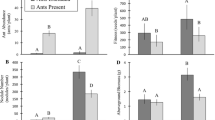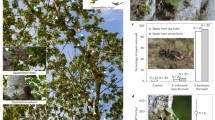Abstract
Soil fertility is understood to act in many indirect ways, in addition to directly providing nutrients to plants. Given that higher order indirect interactions frequently are key to understanding community structure, it would be natural to expect that indirect mutualisms should be as important as other interactions in generating such structure. Although mutualisms are ubiquitous in nature, exploring the myriad ways in which they interconnect with other elements of a system is less common. That soil fertility has an indirect effect on community structure is well known, suggests that soil fertility may be important in determining the effect of mutualisms on the structure of the ecological communities in which they are embedded. Here we report on a laboratory study that specifically examines the direct connection between the behavior of a mutualist and nutritional properties of the soil. We tested the effects of soil fertilization (high, medium and low levels) on the Azteca seriseasur–Coccus viridis mutualism on coffee plants in Mexico. We found that ants foraged significantly more on plants that were infected with C. viridis over control plants. Moreover, ants preferred to tend C. viridis on high fertilized over medium and low fertilized plants. This study highlights the importance of the links between soil nutrient properties and their effects on a key ant-hemipteran mutualism, illustrating the cascading effects on other interactions involving this keystone ant species.




Similar content being viewed by others
Data availability
The data that supports the findings of this study are available in the supplementary material of this article.
References
Abrams PA (1995) Implications of dynamically variable traits for identifying, classifying, and measuring direct and indirect effects in ecological communities. Am Nat 146(1):112–134
Bairey E, Kelsic ED, Kishony R (2016) High-order species interactions shape ecosystem diversity. Nat Commun 7(1):1–7
Bascompte J, Jordano P (2007) Plant-animal mutualistic networks: the architecture of biodiversity. - Annual Review of Ecology. Evolution & Systematics 38:567–593
Bates, D. et al. 2015. Package ‘lme4’. - Convergence. 12:2.
Brown C et al (2019) Species-specific size vulnerabilities in a competitive arena Nutrient heterogeneity and soil fertility alter plant competitive size asymmetries. Funct Ecol 33:1491–1503
Breviglieri CPB, Oliveira PS, Romero GQ (2017) Fear mediates trophic cascades: nonconsumptive effects of predators drive aquatic ecosystem function. Am Nat 189(5):490–500
Buckland SM, Grime JP (2000) The effects of trophic structure and soil fertility on the assembly of plant communities: a microcosm experiment. Oikos 91:336–352
Chase JM et al (2002) The interaction between predation and competition: a review and synthesis. Ecol Lett 5:302–315
Damon A (2000) A review of the biology and control of the coffee berry borer, Hypothenemus hampei (Coleoptera: Scolytidae). Bulletin of Entomol Res 90:453–465
Fraser, L.H. and Grime, J.P. 1999. Interacting effects of herbivory and fertility on a synthesized plant community. –Journal of Ecology 87: 514–525.
Gonthier DJ et al (2013) Bottom-up effects of soil quality on a coffee arthropod interaction web. Ecosphere 4:1–15
Hohberg K, Traunspurger W (2005) Predator–prey interaction in soil food web: functional response, size-dependent foraging efficiency, and the influence of soil texture. Biol Fertility Soils 41:419–427
Janssen A, Bruin J, Jacobs G, Schraag R, Sabelis MW (1997) Predators use volatiles to avoid prey patches with conspecifics. J Anim Ecol 66:223–232
Jansson RK, Smilowitz Z (1986) Influence of nitrogen on population parameters of potato insects: abundance, population growth, and within-plant distribution of the green peach aphid, Myzus persicae (Homoptera: Aphididae). Environ Entomol 15:49–55
Jimenez-Soto E, Morris JR, Letourneau DK, Philpott SM (2019) Vegetation connectivity increases ant activity and potential for ant-provided biocontrol services in a tropical agroforest. Biotropica 51(1):50–61
Kaakeh W et al (1992) Combined effects of spirea aphid (Homoptera: Aphididae) and nitrogen fertilization on net photosynthesis, total chlorophyll content, and greenness of apple leaves. J Economic Entomol 85:939–946
Levine JM et al (2017) Beyond pairwise mechanisms of species coexistence in complex communities. Nature 546:56–64
Liere H, Perfecto I (2014) Cheating on a mutualism: indirect benefits of ant attendance to a coccidophagous coccinellid. Environmental Entomolgy. 37:143–149
Livingston GF et al (2008) Indirect interactions between ant-tended hemipterans, a dominant ant Azteca instabilis (Hymenoptera: Formicidae), and shade trees in a tropical agroecosystem. Environ Entomol 37:734–740
Meyer GA (2000) Interactive effects of soil fertility and herbivory on Brassica nigra. Oikos 88:433–441
Nakagawa S, Johnson P, Schielzeth H (2017) The coefficient of determination R2 and intra-class correlation coefficient from generalized linear mixed-effects models revisted and expanded. J R Soc Interface. https://doi.org/10.1098/rsif.2017.0213
Nowak H, Komor E (2010) How aphids decide what is good for them: experiments to test aphid feeding behaviour on Tanacetum vulgare (L) using different nitrogen regimes. Oecologia 163:973–984
Pope NS, Jha S (2018) Seasonal food scarcity prompts long-distance foraging by a wild social bee. Am Nat 191:45–57
R Core Team. (2020) R: a language and environment for statistical computing (3.6.3) [Computer software].
Rivera-Salinas IS, Hajian-Forooshani Z, Jiménez-Soto E, Cruz-Rodríguez JA, Philpott SM (2018) High intermediary mutualist density provides consistent biological control in a tripartite mutualism. Biol Control 118:26–31
Vandermeer J et al (2010) Ecological complexity and pest control in organic coffee production: uncovering an autonomous ecosystem service. Bioscience 60:527–537
Vandermeer J et al (2019) The community ecology of herbivore regulation in an agroecosystem: lessons from complex systems. Bioscience 69:974–996
Vandermeer J, Perfecto I (2019) Hysteresis and critical transitions in a coffee agroecosystem. PNAS 116:15074–15079
Werner EE, Peacor SD (2003) A review of trait-mediated indirect interactions in ecological communities. Ecology 84(5):1083–1100
Yao I, Akimoto SI (2001) Ant attendance changes the sugar composition of the honeydew of the drepanosiphid aphid Tuberculatus quercicola. Oecologia 128:36–43
Yao I, Akimoto SI (2002) Flexibility in the composition and concentration of amino acids in honeydew of the drepanosiphid aphid Tuberculatus quercicola. Ecological Entomology 27:745–752
Acknowledgements
We are grateful to Peter Walters and Finca Irlanda for allowing us to conduct research on the farm as well as provide us with the coffee seedlings from the nursery. We would like to thank P. Yajnik for help with statistical analysis and K. Sanchez, Z. Hajian-Forooshani, I. Saraeny Rivera Salinas and N. Medina and two anonymous reviewers for helpful comments on earlier versions of the manuscript.
Funding
This study was funded by UM Rackham graduate student research Grant and UM ecology & Evolutionary Biology block grant, with support from the US National Science Foundation, DEB 1853261.
Author information
Authors and Affiliations
Contributions
C.V. conceived the study; C.V. and J.V. designed the study; C.V. collected the data; C.V. analyzed the data; C.V. wrote the manuscript; J.V. helped with editing the manuscript.
Corresponding author
Ethics declarations
Conflict of interest
The authors declare no conflict of interest. The funding sponsors had no role in the design of the study.
Additional information
Handling Editor: Heikki Hokkanen.
Publisher's Note
Springer Nature remains neutral with regard to jurisdictional claims in published maps and institutional affiliations.
Supplementary Information
Below is the link to the electronic supplementary material.
Rights and permissions
About this article
Cite this article
Vaidya, C., Vandermeer, J. Ant’s choice: The effect of nutrients on a key ant–hemipteran mutualism. Arthropod-Plant Interactions 15, 545–550 (2021). https://doi.org/10.1007/s11829-021-09833-5
Received:
Accepted:
Published:
Issue Date:
DOI: https://doi.org/10.1007/s11829-021-09833-5




